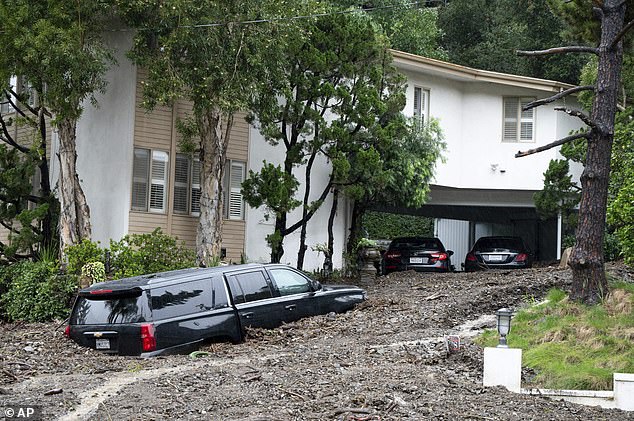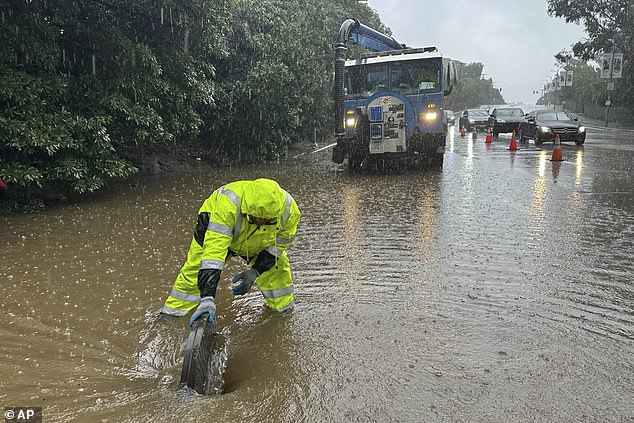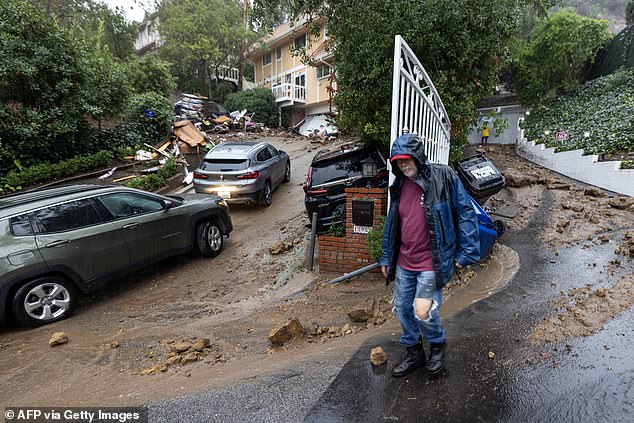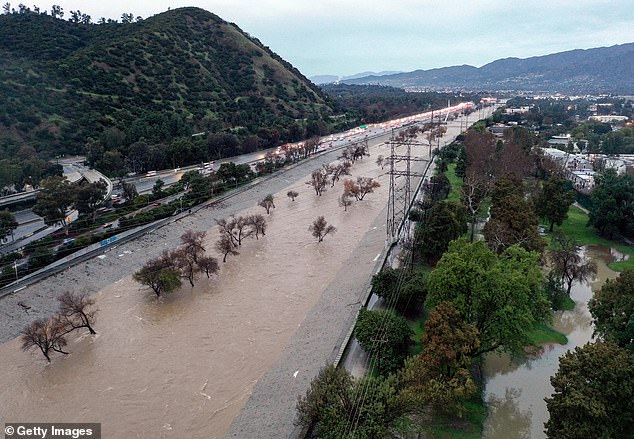Table of Contents
Three people have died in the historic flood that hit Californiadestroying homes and communities across the state.
Back-to-back ‘Pineapple Express’ storms, fueled by an atmospheric river, have caused chaos in the neighborhoods of Malibu, Beverly Hills and Montecito.
The weather system has downed power lines and trees in the San Francisco Bay Area and San Diego, while the state experiences ferocious mudslides and torrential downpours.
Meteorologists predict the atmospheric river. will continue to focus across Southern California over the next 12 to 24 hours, maintaining a significant threat of life-threatening flash flooding.
Qian Ciao, a hydrologist at the University of California, San Diego, explains why these devastating floods occur.
Three people have lost their lives as a weather system, the Pineapple Express, continues to batter California

Areas of the state have already experienced nine inches of rain and forecasters predict there will be up to six more. In the photo, a tree fell on a car in the California floods.
What is an atmospheric river?
Atmospheric rivers are relatively long, narrow regions that transport water vapor away from the tropics.
Qian Cao explained to PBS They are “like a river in the sky” and can be up to 1,000 miles long.
Typically, atmospheric rivers have twice the flow of the Amazon River and account for most of the world’s water vapor, NASA reports.
When this moving water vapor collides with mountains or divergent local climates, it is forced to fall, meaning the moisture it contains cools and produces heavy rain or snowfall.
Atmospheric rivers can appear anywhere in the world; However, they are primarily found in the planet’s mid-latitudes, approximately 30 to 60 degrees north or south of the equator.
This climate phenomenon usually occurs when large-scale weather patterns synchronize to form narrow stretches of intense moisture transport, Cao explained.
He told PBS: “These start in warm waters, typically tropical oceans, and are guided toward the coast by low-level jet streams ahead of cold fronts of extratropical cyclones.”
The hydrologist disclosed that the Pacific Ocean, which runs along the west coast of the United States, acts as a pool of moisture for storms.
This, along with the area’s mountainous terrain that acts as a barrier, causes a large amount of snow and rain in the state, specifically in the Sierra Nevada.

Atmospheric rivers are relatively long, narrow regions that transport water vapor away from the tropics. In the photo a large landslide in Los Angeles
Do consecutive atmospheric rivers have a high risk of flooding?
Consecutive atmospheric rivers. Also known as AR families, they can cause significantly severe flooding. explained the hydrologist.
The first bout of heavy rain soaks the ground, meaning that when more rain or storms come, the ground can no longer absorb any liquid, meaning water builds up as river levels continue to rise.
Additionally, warm temperatures can cause existing snow to melt, contributing to water overflow and the risk of flooding.
Between December 2022 and January 2023, California was hit by nine consecutive atmospheric rivers in just three weeks, according to PBS.
Although they returned most of the area’s reservoirs to their average levels after many years of drought, they also caused damage due to flooding.
Compared to a singular atmospheric river, AR families are typically linked to lower atmospheric pressure in the North Pacific and higher climatic pressure in the subtropics.
AR families are more intense, have warmer tropical temperatures, and are followed by jet streams that are longer than a singular atmospheric river.
Research by scientists at the University of Florida and Stanford found that storms that occurred alongside AR families caused three to four times more economic damage than a lone storm.

Although AR families contribute a large portion of California’s water supply, they also cause extreme flooding and damage (pictured: a whirlpool forms around a city worker in the Holmby Hills neighborhood of Los Angeles on Monday).
Are atmospheric rivers essential to the west coast’s water supply?
While atmospheric rivers can cause extreme flooding, Cao explains that they are also key to Western water supplies.
He said: “Atmospheric rivers have been responsible for ending more than a third of the region’s major droughts, including the severe California drought from 2012 to 2016.”
The hydrologist added that this type of climate phenomenon is also responsible for providing between 30 and 50 percent of the precipitation on the west coast of the United States.
According to Cao, atmospheric rivers are responsible for increasing the Sierra Nevada snowpack, which acts as a significant amount of California’s water supply.
On average, two severe atmospheric rivers will contribute 30 to 40 percent of the snowfall in the Sierra Nevada.
As a result, experts at the Center for Western Climate and Aquatic Extremes are trying to better predict atmospheric rivers, so that reservoirs can be better managed to accommodate storms but also have enough water for drier weather events.

Hydrologist Qian Ciao predicts that as temperatures rise, more intense atmospheric rivers will occur in the coming years (pictured: storm damage in Studio City)
Is global warming having an impact on atmospheric rivers?
A warmer atmosphere can transport more moisture, meaning that as temperatures rise in the future, atmospheric rivers will be produced that will be more intense.
According to Cao, this will cause more heavy rain and extreme weather events.
He added that his research illustrates that atmospheric rivers are likely to occur simultaneously in climatic conditions that are already humid.
According to the hydrologist, this means an increased risk of extreme flooding.
A study by academics at the University of Washington implies that atmospheric rivers will experience a “seasonal shift,” occurring earlier in wetter seasons.
The hydrologist explained that annual rainfall, especially in California, will vary more drastically from year to year.

